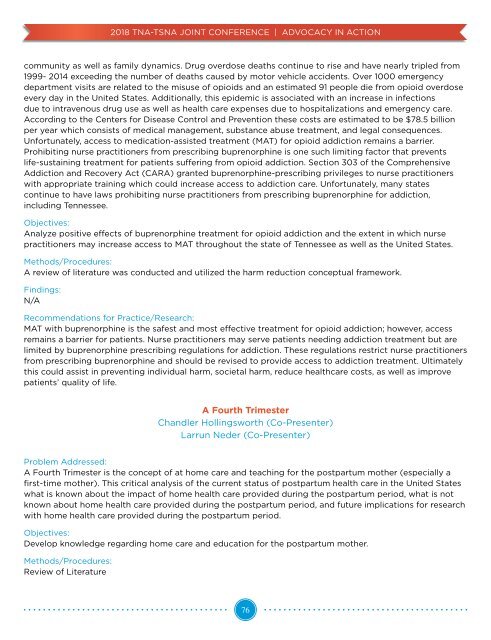2018 TNA and TSNA Joint Annual Conference
Create successful ePaper yourself
Turn your PDF publications into a flip-book with our unique Google optimized e-Paper software.
<strong>2018</strong> <strong>TNA</strong>-<strong>TSNA</strong> JOINT CONFERENCE | ADVOCACY IN ACTION<br />
community as well as family dynamics. Drug overdose deaths continue to rise <strong>and</strong> have nearly tripled from<br />
1999- 2014 exceeding the number of deaths caused by motor vehicle accidents. Over 1000 emergency<br />
department visits are related to the misuse of opioids <strong>and</strong> an estimated 91 people die from opioid overdose<br />
every day in the United States. Additionally, this epidemic is associated with an increase in infections<br />
due to intravenous drug use as well as health care expenses due to hospitalizations <strong>and</strong> emergency care.<br />
According to the Centers for Disease Control <strong>and</strong> Prevention these costs are estimated to be $78.5 billion<br />
per year which consists of medical management, substance abuse treatment, <strong>and</strong> legal consequences.<br />
Unfortunately, access to medication-assisted treatment (MAT) for opioid addiction remains a barrier.<br />
Prohibiting nurse practitioners from prescribing buprenorphine is one such limiting factor that prevents<br />
life-sustaining treatment for patients suffering from opioid addiction. Section 303 of the Comprehensive<br />
Addiction <strong>and</strong> Recovery Act (CARA) granted buprenorphine-prescribing privileges to nurse practitioners<br />
with appropriate training which could increase access to addiction care. Unfortunately, many states<br />
continue to have laws prohibiting nurse practitioners from prescribing buprenorphine for addiction,<br />
including Tennessee.<br />
Objectives:<br />
Analyze positive effects of buprenorphine treatment for opioid addiction <strong>and</strong> the extent in which nurse<br />
practitioners may increase access to MAT throughout the state of Tennessee as well as the United States.<br />
Methods/Procedures:<br />
A review of literature was conducted <strong>and</strong> utilized the harm reduction conceptual framework.<br />
Findings:<br />
N/A<br />
Recommendations for Practice/Research:<br />
MAT with buprenorphine is the safest <strong>and</strong> most effective treatment for opioid addiction; however, access<br />
remains a barrier for patients. Nurse practitioners may serve patients needing addiction treatment but are<br />
limited by buprenorphine prescribing regulations for addiction. These regulations restrict nurse practitioners<br />
from prescribing buprenorphine <strong>and</strong> should be revised to provide access to addiction treatment. Ultimately<br />
this could assist in preventing individual harm, societal harm, reduce healthcare costs, as well as improve<br />
patients’ quality of life.<br />
A Fourth Trimester<br />
Ch<strong>and</strong>ler Hollingsworth (Co-Presenter)<br />
Larrun Neder (Co-Presenter)<br />
Problem Addressed:<br />
A Fourth Trimester is the concept of at home care <strong>and</strong> teaching for the postpartum mother (especially a<br />
first-time mother). This critical analysis of the current status of postpartum health care in the United States<br />
what is known about the impact of home health care provided during the postpartum period, what is not<br />
known about home health care provided during the postpartum period, <strong>and</strong> future implications for research<br />
with home health care provided during the postpartum period.<br />
Objectives:<br />
Develop knowledge regarding home care <strong>and</strong> education for the postpartum mother.<br />
Methods/Procedures:<br />
Review of Literature<br />
76

















